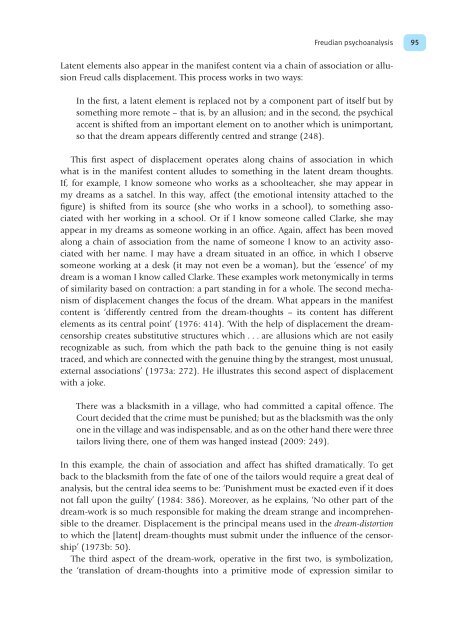Cultural Theory and Popular Culture
Cultural Theory and Popular Culture
Cultural Theory and Popular Culture
You also want an ePaper? Increase the reach of your titles
YUMPU automatically turns print PDFs into web optimized ePapers that Google loves.
Freudian psychoanalysis 95<br />
Latent elements also appear in the manifest content via a chain of association or allusion<br />
Freud calls displacement. This process works in two ways:<br />
In the first, a latent element is replaced not by a component part of itself but by<br />
something more remote – that is, by an allusion; <strong>and</strong> in the second, the psychical<br />
accent is shifted from an important element on to another which is unimportant,<br />
so that the dream appears differently centred <strong>and</strong> strange (248).<br />
This first aspect of displacement operates along chains of association in which<br />
what is in the manifest content alludes to something in the latent dream thoughts.<br />
If, for example, I know someone who works as a schoolteacher, she may appear in<br />
my dreams as a satchel. In this way, affect (the emotional intensity attached to the<br />
figure) is shifted from its source (she who works in a school), to something associated<br />
with her working in a school. Or if I know someone called Clarke, she may<br />
appear in my dreams as someone working in an office. Again, affect has been moved<br />
along a chain of association from the name of someone I know to an activity associated<br />
with her name. I may have a dream situated in an office, in which I observe<br />
someone working at a desk (it may not even be a woman), but the ‘essence’ of my<br />
dream is a woman I know called Clarke. These examples work metonymically in terms<br />
of similarity based on contraction: a part st<strong>and</strong>ing in for a whole. The second mechanism<br />
of displacement changes the focus of the dream. What appears in the manifest<br />
content is ‘differently centred from the dream-thoughts – its content has different<br />
elements as its central point’ (1976: 414). ‘With the help of displacement the dreamcensorship<br />
creates substitutive structures which . . . are allusions which are not easily<br />
recognizable as such, from which the path back to the genuine thing is not easily<br />
traced, <strong>and</strong> which are connected with the genuine thing by the strangest, most unusual,<br />
external associations’ (1973a: 272). He illustrates this second aspect of displacement<br />
with a joke.<br />
There was a blacksmith in a village, who had committed a capital offence. The<br />
Court decided that the crime must be punished; but as the blacksmith was the only<br />
one in the village <strong>and</strong> was indispensable, <strong>and</strong> as on the other h<strong>and</strong> there were three<br />
tailors living there, one of them was hanged instead (2009: 249).<br />
In this example, the chain of association <strong>and</strong> affect has shifted dramatically. To get<br />
back to the blacksmith from the fate of one of the tailors would require a great deal of<br />
analysis, but the central idea seems to be: ‘Punishment must be exacted even if it does<br />
not fall upon the guilty’ (1984: 386). Moreover, as he explains, ‘No other part of the<br />
dream-work is so much responsible for making the dream strange <strong>and</strong> incomprehensible<br />
to the dreamer. Displacement is the principal means used in the dream-distortion<br />
to which the [latent] dream-thoughts must submit under the influence of the censorship’<br />
(1973b: 50).<br />
The third aspect of the dream-work, operative in the first two, is symbolization,<br />
the ‘translation of dream-thoughts into a primitive mode of expression similar to
















